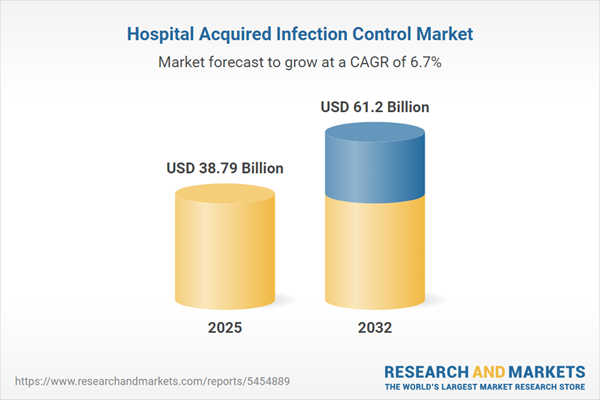Speak directly to the analyst to clarify any post sales queries you may have.
The Hospital Acquired Infection Control Market continues to reshape best practices in healthcare, as global providers seek robust solutions that anticipate risks, strengthen institutional compliance, and deliver operational resilience.
Market Snapshot: Hospital Acquired Infection Control Market
In 2024, the Hospital Acquired Infection Control Market reached USD 36.39 billion and is projected to expand to USD 38.79 billion by 2025, registering a CAGR of 6.71 percent. By 2032, estimates position the market at USD 61.20 billion. This growth is powered by systematic infection prevention initiatives, increasing digitalization throughout healthcare environments, and enhanced collaboration among institutions, resulting in stronger regulatory alignment and a quality-first focus. As healthcare organizations adopt these strategies, they build greater capability for benchmarking, faster response to compliance updates, and higher transparency across networks.
Scope & Segmentation
- Product Types: Air purification systems—including HEPA and UV filtration—reduce airborne pathogen exposure by continuously managing indoor air quality. Antimicrobial coatings extend the durability and safeguard of medical devices and surfaces, delivering lasting protection. Hand hygiene solutions, from gels to wipes, address compliance standards crucial to limiting surface-to-surface transmission in complex care settings. Sterilization solutions utilize advanced processes such as low-temperature, steam, ethylene oxide, and vaporized hydrogen peroxide to ensure thorough reprocessing for reusable equipment. Environmental cleaning relies on surface disinfectants formulated with chlorine, peroxygen, alcohol, or quaternary ammonium compounds for consistent disinfection. Ultraviolet disinfection devices—both static and mobile—enable adaptable and focused decontamination. Water treatment technologies apply filtration and specialized chemicals to safeguard water supplies crucial for clinical operations.
- Application Environments: Emergency departments, wards, operating rooms, intensive care, pediatric units, and specialty clinics follow tailored protocols to address infection risks inherent to each care environment. Outpatient and ambulatory centers deploy adapted protection strategies that reflect shifting patient interactions and care flows.
- Regional Coverage: The Americas, including the US, Canada, Mexico, and parts of Latin America, utilize advanced procurement approaches and adhere to demanding regulatory expectations. EMEA encompasses both established markets, such as the UK, Germany, and France, and rapidly evolving areas in the Middle East and Africa, including the UAE, Saudi Arabia, South Africa, and Nigeria. Asia-Pacific is marked by diverse regulatory frameworks and emerging innovations, with momentum in China, India, Japan, Australia, and South Korea fostering dynamic industry progress.
- Key Companies: Leading firms—including Ecolab Inc., 3M Company, Danaher Corporation, STERIS plc, Getinge AB, Johnson & Johnson, Cardinal Health, B. Braun Melsungen AG, Mölnlycke Health Care AB, and Ansell Limited—direct product innovation and shape competitive benchmarks for infection control worldwide.
Key Takeaways for Senior Decision-Makers
- Integrating digital tools with established hygiene protocols enables timely mitigation of emerging infection threats and supports risk management strategies.
- Developing procurement plans aligned to evolving regulatory demands ensures consistent supply chain integrity and institutional accountability.
- Adopting real-time monitoring and IoT-enabled sterilization processes improves contamination detection and helps standardize compliance practices across sites.
- Cultivating collaboration among clinical leaders, executive teams, and technology vendors supports balanced protocol development, optimizing both efficiency and compliance outcomes.
- Regional infrastructure gaps require flexible supply approaches, allowing organizations to manage product availability and adapt to fluctuating demand in varying markets.
- Implementing outcome-oriented modular solutions provides a scalable approach to enhancing care quality, addressing resource constraints and supporting growth.
Tariff Impact on Infection Control Product Supply Chains
Planned US tariffs in 2025 are set to raise costs on infection control products containing imported stainless steel and electronic components. Procurement executives are diversifying their supplier portfolios, increasing nearshore manufacturing commitments, and forging stronger international partnerships. These steps protect supply resilience and support consistent product standards during periods of rising demand and regulatory scrutiny.
Methodology & Data Sources
This report synthesizes expert clinical input, up-to-date regulatory policy review, and ongoing trend analysis. Data were validated using direct interviews with both infection control and procurement leaders, and further substantiated through triangulation of multiple reputable industry sources.
Why This Report Matters for Infection Control Leadership
- Detailed segmentation and trend analysis provide senior leadership with actionable insights for strategic investment and risk planning across infection prevention efforts.
- Guidance on technology adoption and adaptation to diverse geographic standards ensures flexible, robust supply chains and sustained organizational competitiveness.
- Practical recommendations enable faster protocol optimization and efficient resource deployment to achieve institutional compliance and care outcome goals.
Conclusion
Adopting advanced infection control solutions and anticipating regulatory changes allows healthcare leaders to reinforce risk management strategies and maintain high standards in infection prevention. Strategic leadership remains central to driving sustainable operational excellence and care quality.
Additional Product Information:
- Purchase of this report includes 1 year online access with quarterly updates.
- This report can be updated on request. Please contact our Customer Experience team using the Ask a Question widget on our website.
Table of Contents
3. Executive Summary
4. Market Overview
7. Cumulative Impact of Artificial Intelligence 2025
Companies Mentioned
The companies profiled in this Hospital Acquired Infection Control market report include:- Ecolab Inc.
- 3M Company
- Danaher Corporation
- STERIS PLC
- Getinge AB
- Johnson & Johnson
- Cardinal Health, Inc.
- B. Braun Melsungen AG
- Mölnlycke Health Care AB
- Ansell Limited
Table Information
| Report Attribute | Details |
|---|---|
| No. of Pages | 190 |
| Published | November 2025 |
| Forecast Period | 2025 - 2032 |
| Estimated Market Value ( USD | $ 38.79 Billion |
| Forecasted Market Value ( USD | $ 61.2 Billion |
| Compound Annual Growth Rate | 6.7% |
| Regions Covered | Global |
| No. of Companies Mentioned | 11 |









